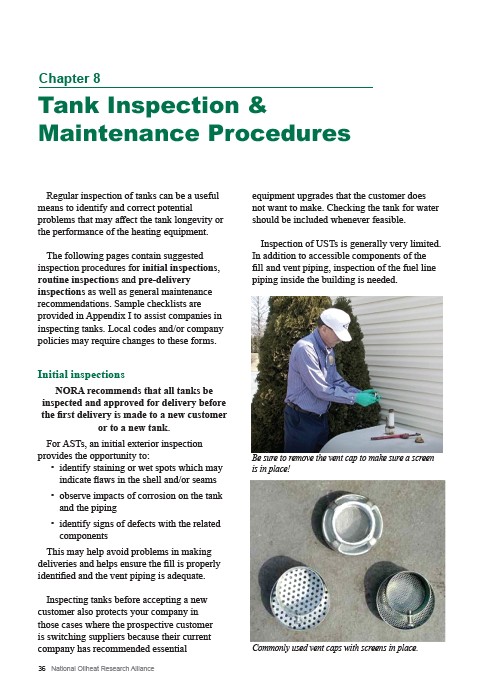
Chapter 8
Tank Inspection &
Maintenance Procedures
Regular inspection of tanks can be a useful
means to identify and correct potential
problems that may affect the tank longevity or
the performance of the heating equipment.
The following pages contain suggested
inspection procedures for initial inspections,
routine inspections and pre-delivery
inspections as well as general maintenance
recommendations. Sample checklists are
provided in Appendix I to assist companies in
inspecting tanks. Local codes and/or company
policies may require changes to these forms.
Initial inspections
NORA recommends that all tanks be
inspected and approved for delivery before
the first delivery is made to a new customer
or to a new tank.
For ASTs, an initial exterior inspection
provides the opportunity to:
• identify staining or wet spots which may
indicate flaws in the shell and/or seams
• observe impacts of corrosion on the tank
and the piping
• identify signs of defects with the related
components
This may help avoid problems in making
deliveries and helps ensure the fill is properly
identified and the vent piping is adequate.
Inspecting tanks before accepting a new
customer also protects your company in
those cases where the prospective customer
is switching suppliers because their current
company has recommended essential
36 National Oilheat Research Alliance
equipment upgrades that the customer does
not want to make. Checking the tank for water
should be included whenever feasible.
Inspection of USTs is generally very limited.
In addition to accessible components of the
fill and vent piping, inspection of the fuel line
piping inside the building is needed.
Be sure to remove the vent cap to make sure a screen
is in place!
Commonly used vent caps with screens in place.